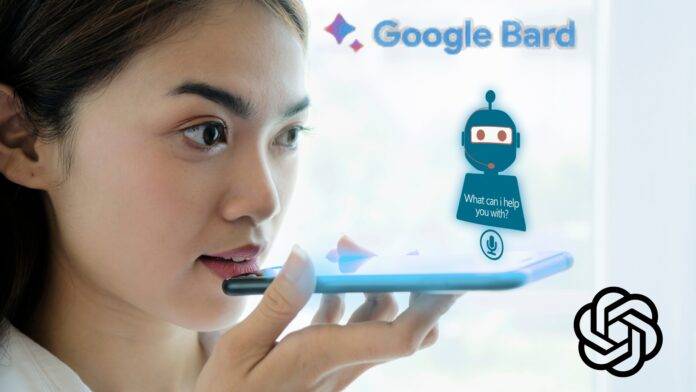Curious about the best AI chatbot? Explore the ultimate showdown between Google Bard and ChatGPT! Discover their unique features, capabilities, and decide which AI chatbot reigns supreme. Dive into the fascinating world of artificial intelligence and make an informed choice for your chatbot needs. Don’t miss out on this exciting comparison!
Google Bard vs ChatGPT: Discover the Ultimate AI Chatbot Showdown!
In today’s rapidly evolving technological landscape, artificial intelligence (AI) chatbots have gained significant attention for their ability to interact with users and provide intelligent responses.

Google Bard and ChatGPT are two prominent AI chatbot platforms that have revolutionized how we engage in online conversations.
In this article, we will explore the features, capabilities, and drawbacks of Google Bard and ChatGPT to determine which stands out as the best AI chatbot solution.
Introduction | Google Bard vs ChatGPT
As AI chatbots become increasingly prevalent in various industries, evaluating their performance, natural language processing abilities, user interaction skills, and overall effectiveness is crucial. In this article, we will compare Google Bard and ChatGPT to ascertain their strengths and weaknesses, helping you decide when to choose an AI chatbot for your specific needs.
What is Google Bard?
Google Bard is an AI chatbot developed by Google that leverages advanced natural language processing algorithms to engage in meaningful conversations with users. It utilizes cutting-edge machine-learning techniques to understand context, infer intent, and generate relevant responses. Google Bard is designed to provide a seamless and interactive user experience across various platforms and applications.
What is ChatGPT?
ChatGPT, on the other hand, is an AI chatbot powered by OpenAI’s GPT (Generative Pre-trained Transformer) technology. It is trained on a vast corpus of text from the internet, enabling it to generate human-like responses to user queries. ChatGPT has gained widespread popularity for its ability to engage in dynamic and contextually rich conversations, making it a versatile tool for businesses and individuals.
Comparison of Features
Natural Language Processing Abilities
- Regarding natural language processing (NLP) abilities, both Google Bard and ChatGPT excel in their respective domains.
- Google Bard harnesses Google’s extensive linguistic resources and advanced machine-learning models to understand complex user queries and generate accurate responses.
- It can comprehend nuanced sentences, handle multiple languages, and adapt to various conversational styles.
- Similarly, ChatGPT demonstrates impressive NLP capabilities by generating coherent and contextually relevant responses. It can grasp the meaning behind user input, interpret ambiguous queries, and provide appropriate answers.
- However, it’s worth noting that ChatGPT may occasionally generate responses that lack coherence or fail to address the user’s intent due to the limitations of the underlying training data.
User Interaction and Conversational Skills
- Both Google Bard and ChatGPT strive to offer engaging and conversational experiences to users. Google Bard is designed to simulate human-like interactions, incorporating humor, empathy, and personality traits into its responses.
- It can generate witty and contextually appropriate replies, enhancing the user’s engagement and satisfaction.
- ChatGPT also excels in user interaction, often generating detailed and informative responses.
- However, it may be more formal and need help developing concise answers to specific queries.
- OpenAI has tried to mitigate these limitations, but occasional shortcomings in conversational flow still exist.
Understanding Context and Intent
- Understanding the context and intent behind user queries is crucial to provide accurate and relevant responses.
- In this aspect, Google Bard has an edge, thanks to Google’s vast knowledge graph and the ability to leverage contextual information effectively.
- It can grasp the nuances of a conversation, maintain context over extended dialogues, and provide insightful answers based on the user’s input.
- ChatGPT also demonstrates a commendable understanding of context and intent, but its performance may vary depending on the complexity of the conversation.
- While it can handle sequential prompts reasonably well, it may need help with long-term context retention and occasionally generate responses that lack coherence.
Performance and Reliability
Performance and reliability are crucial factors when evaluating AI chatbots.
- Google Bard benefits from Google’s robust infrastructure and resources, ensuring high uptime and responsiveness.
- It can handle large requests simultaneously, providing a smooth and seamless user experience.
- ChatGPT, being an OpenAI product, has also made significant strides in performance and reliability.
- However, during peak usage times, there might be occasional delays in response time due to the limitations of the underlying infrastructure.
- OpenAI is actively working to improve the scalability and reliability of the system.
Integration and Customization Options
- Both Google Bard and ChatGPT offer integration options and customization capabilities to cater to different use cases.
- Google Bard provides APIs and developer tools that enable seamless integration with various applications and platforms.
- It offers flexibility in customizing the chatbot’s behavior, personality, and visual representation to align with specific branding requirements.
- ChatGPT also offers API access and allows developers to customize its behavior to a certain extent.
- While it doesn’t provide the same level of control over the chatbot’s personality as Google Bard, it still offers sufficient flexibility for integrating the chatbot into different applications and environments.
Use Cases and Applications
- Google Bard and ChatGPT find applications in diverse domains and industries. Google Bard’s robustness and extensive knowledge base make it well-suited for providing customer support, answering factual queries, and assisting with general information retrieval.
- It can also be integrated into voice assistants and smart devices to enhance user interactions.
- ChatGPT, with its versatility and ability to generate creative responses, finds applications in content creation, brainstorming sessions, and interactive storytelling.
- It can be a virtual writing assistant, helping users draft articles, generate ideas, and provide conversational entertainment.
Pricing and Accessibility

- Google Bard’s pricing and accessibility depend on the specific implementation and use case. It is part of Google’s suite of AI services, and the pricing structure varies based on usage volume, customization requirements, and enterprise-level support.
- Google offers different pricing plans to cater to businesses of all sizes.
- ChatGPT, on the other hand, offers free access and a subscription-based plan called ChatGPT Plus.
- The free access allows users to interact with the chatbot but may have limited response times and availability during peak usage.
- ChatGPT Plus offers enhanced benefits such as faster response times and priority access, available at a monthly subscription fee.
Pros and Cons of Google Bard
Pros:
- Advanced natural language processing capabilities
- Seamless integration with Google’s ecosystem
- Extensive knowledge graph for accurate responses
- Robust infrastructure for high performance and reliability
Cons:
- Limited customization options for the chatbot’s personality
- Pricing may be higher compared to some alternatives
- Customization and integration options may require technical expertise
Pros and Cons of ChatGPT
Pros:
- Impressive natural language processing abilities
- Versatile and creative responses
- Accessible free version and subscription-based plan
- Continuous updates and improvements from OpenAI
Cons:
- Occasional generation of incoherent or irrelevant responses
- Limited control over chatbot personality and behavior
- Response times may vary during peak usage
Visit Google Bard Website : Transform your content creation with Google Bard: Unleash the writer within
Conclusion
When it comes to choosing the best AI chatbot between Google Bard and ChatGPT, it ultimately depends on your specific requirements and priorities.
If you prioritize robust natural language processing, contextual understanding, and integration with Google’s ecosystem, Google Bard may be your ideal choice. On the other hand, if you value versatility, creativity, and accessibility, ChatGPT offers a compelling option with its impressive language generation capabilities and accessible pricing plans.
Both Google Bard and ChatGPT have their strengths and weaknesses, and the decision should be based on factors such as the intended use case, desired customization options, and budget constraints.
It’s advisable to thoroughly evaluate the features, consider real-world use cases, and even try out the chatbots firsthand to make an informed decision.
Visit ChatGpt Website: Unlock the power of AI-driven conversations with Chat GPT. Start chatting now and experience the future of communication
FAQs
Can I use Google Bard and ChatGPT for customer support?
Both chatbots can be used for customer support, but Google Bard may have an edge in understanding complex queries and providing accurate responses.
Are there any limitations on the length of conversations with ChatGPT?
ChatGPT does have limitations on the length of conversations it can effectively handle. Very long discussions may result in incomplete or truncated responses.
Can I customize the personality of Google Bard?
While Google Bard offers some customization options, the level of control over the chatbot’s personality is limited compared to ChatGPT.
Which chatbot is more suitable for content creation and brainstorming?
ChatGPT is particularly well-suited for content creation and brainstorming due to its versatility and ability to generate creative responses.
What are the pricing options for Google Bard and ChatGPT?
Google Bard’s pricing depends on usage and customization requirements, while ChatGPT offers a free access version and a subscription-based plan called ChatGPT Plus.

